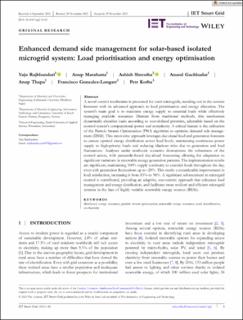| dc.contributor.author | Rajbhandari, Yaju | |
| dc.contributor.author | Marahatta, Anup | |
| dc.contributor.author | Shrestha, Ashish | |
| dc.contributor.author | Gachhadar, Anand | |
| dc.contributor.author | Thapa, Anup | |
| dc.contributor.author | Gonzalez-Longatt, Francisco | |
| dc.contributor.author | Korba, Petr | |
| dc.date.accessioned | 2024-04-11T12:46:09Z | |
| dc.date.available | 2024-04-11T12:46:09Z | |
| dc.date.created | 2024-01-02T13:09:26Z | |
| dc.date.issued | 2023 | |
| dc.identifier.citation | Rajbhandari, Y., Marahatta, A., Shrestha, A., Gachhadar, A., Thapa, A., Gonzalez-Longatt, F., & Korba, P. (2023). Enhanced demand side management for solar-based isolated microgrid system: Load prioritisation and energy optimisation. IET Smart Grid, 1-20. | en_US |
| dc.identifier.issn | 2515-2947 | |
| dc.identifier.uri | https://hdl.handle.net/11250/3126134 | |
| dc.description.abstract | A novel control mechanism is presented for rural microgrids, standing out in the current literature with its advanced approach to load prioritisation and energy allocation. The system's main goal is to maximise energy supply to essential loads while effectively managing available resources. Distinct from traditional methods, this mechanism dynamically classifies loads according to user-defined priorities, adjustable based on the control system's computational power and complexity. A critical feature is the utilisation of the Particle Swarm Optimisation (PSO) algorithm to optimise demand side management (DSM). This innovative approach leverages day-ahead load and generation forecasts to ensure optimal energy distribution across load levels, maintaining continuous power supply to high-priority loads and reducing blackout risks due to generation and load fluctuations. Analyses under stochastic scenarios demonstrate the robustness of the control action, with percentile-based day-ahead forecasting allowing for adaptation to significant variations in renewable energy generation patterns. The implementation results are significant, maintaining 100% supply continuity to essential loads throughout the day, even with generation fluctuations up to -20%. This marks a considerable improvement in load satisfaction, increasing it from 83% to 96%. A significant advancement in microgrid control is contributed, providing an adaptive, user-centric approach that enhances load management and energy distribution, and facilitates more resilient and efficient microgrid systems in the face of highly variable renewable energy sources (RESs). | en_US |
| dc.language.iso | eng | en_US |
| dc.rights | Attribution-NonCommercial-NoDerivatives 4.0 Internasjonal | * |
| dc.rights.uri | http://creativecommons.org/licenses/by-nc-nd/4.0/deed.no | * |
| dc.title | Enhanced demand side management for solar-based isolated microgrid system: Load prioritisation and energy optimisation | en_US |
| dc.type | Peer reviewed | en_US |
| dc.type | Journal article | en_US |
| dc.description.version | publishedVersion | en_US |
| dc.rights.holder | © 2023 The Authors. | en_US |
| dc.source.pagenumber | 20 | en_US |
| dc.source.journal | IET Smart Grid | en_US |
| dc.identifier.doi | https://doi.org/10.1049/stg2.12151 | |
| dc.identifier.cristin | 2218942 | |
| cristin.ispublished | true | |
| cristin.fulltext | original | |
| cristin.qualitycode | 1 | |

